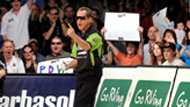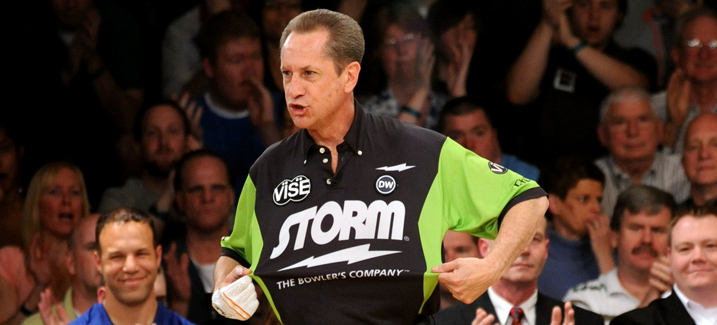Weber sets sights on elusive Masters title

 Even this past Sunday at the PBA Earl Anthony Memorial Classic, where the 48-year-old Hall of Famer made his first TV appearance of the 2010-2011 PBA season, Pete Weber had it—that look in his eyes once described as “chilling enough to make small children cringe in fear.”
Even this past Sunday at the PBA Earl Anthony Memorial Classic, where the 48-year-old Hall of Famer made his first TV appearance of the 2010-2011 PBA season, Pete Weber had it—that look in his eyes once described as “chilling enough to make small children cringe in fear.”
After watching twin messengers topple the 7-10 split that stood after a pocket shot, handing him another strike in his match against Patrick Allen, the man now known as “PDW” slowly walked backwards to his seat with a stare fixed on the rack of pins he just blew into the pit.
It was the look of a gunslinger shoving his smoking pistol back in its holster after firing a shot, the “controlled fire” a fan saw in his eyes at the 2000 Masters, where he went undefeated in match play to take another crack at the major his Hall-of-Fame father, Dick Weber, never won.
There, he toppled a 2-pin on a light hit in the second frame of the title match and nearly leapt out of his shoes with an enraged hand slap. Pete has been no stranger to rage over the years, and on this particular day his rage found a very specific target: then-PBA Commissioner Mark Gerberich, who had recently handed Weber a 10-month suspension from the PBA for a conduct violation.
Weber bowled the event as a USBC member instead and did what he always does when he’s got something to prove: He led qualifying and logged a match play average of 233 while hammering all comers into the ground. That is how it was, too, when he trounced David Ozio in the title match of the 1997 PBA National Championship, 277-236, on the heels of yet another suspension for complaining about lane conditions.
“Personally, winning the PBA National means they can take their suspension and stick it,” he said in a Bowling Magazine story at the time.
And after winning his 35th title at the PBA Marathon Open last year in Baltimore, Weber found someone else who could stick it—this time, everyone who dared to doubt that PDW had another title in him.
“For those of you that thought I was never gonna win again, take that,” he said after the victory.
Opponent Mike Scroggins was bowling to beat out Walter Ray Williams Jr. for Player of the Year honors. Weber made sure no one would be grabbing glory at his expense. With his slicked-back hair and signature Oakleys flashing under the TV lights, he dizzied Scroggins with a blitz of fist pumps and crotch chops in perhaps the most thrilling title match of the entire season.

Weber’s rage over his 10-month suspension in 2000 armed him with just as many shouts and fist pumps as he brandished that day in Baltimore. Twice he had made the show at the major his father had never won, falling short in 1983 and ’85. Both times, he listened all week to questions about carving his own legacy.
By 2000, in full possession of the legacy critics defied him to seize, the question had changed: Would this be the year he finally would add a Masters title to his wins at the U.S. Open, Tournament of Champions and PBA National Championship? Would this be the year he nabbed pro bowling’s “Grand Slam” of majors?
Fans may have recognized a familiar fire in Pete Weber’s eyes, and he may have obliterated the field all week, but he still had one more match to go, and all the fire and match play wins in the world would do nothing to console him if he had to leave town without the trophy.
Weber’s opponent on the show that week? A guy named Mika Koivuniemi. Perhaps you’ve heard of him. You know, the one who is a quarter-of-a-million dollars richer today than he was a couple of weeks ago, thanks to an unprecedented prize fund at the 2011 PBA Tournament of Champions.
But back in 2000, the Mika Koivuniemi who stepped inside the National Bowling Stadium in Reno to make the first TV appearance of his PBA career was a man known only for achievements at events with names like “Hoinke” and “The Santa Claus Open,” a member of the Finnish national bowling team who had recently moved to the United States with nothing more than six suitcases to his name. But Koivuniemi had some history of his own to chase—the chance to make his first national title a major, and the chance to become the first international player ever to win the Masters. The five-bagger he threw in the middle of the match proved just the thing he needed to run that history down—all by the margin of a single pin, 236-235.
But Koivuniemi had some history of his own to chase—the chance to make his first national title a major, and the chance to become the first international player ever to win the Masters. The five-bagger he threw in the middle of the match proved just the thing he needed to run that history down—all by the margin of a single pin, 236-235.
No one wonders who Mika Koivuniemi is any more. But with the 60th USBC Masters on the way, many wonder when, if ever, Weber will live down the gut-punch of that single-pin loss ten years ago, the Grand Slam that slipped through his fingers that day, those close calls back in the 1980s.
The Pete Weber who returns to the National Bowling Stadium in Reno this year for another shot at a Masters title may be a bit older now, and he may be less than two years away from a debut on the Senior Tour even though he still displays the antics of an amped-up teenager whenever he makes a show. But he has also cracked the top 20 in four tournaments this season, finishing third last week, 17th at two of the five events at the World Series of Bowling, and 20th in the World Championship standings.
If momentum means anything in professional sports, Weber at least has that much going for him this time.





